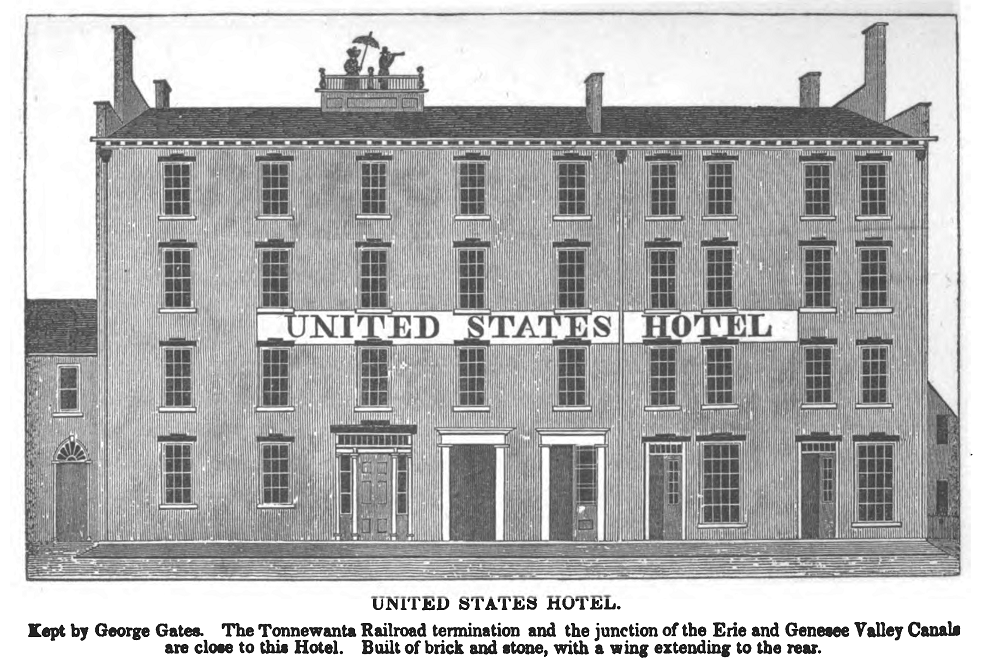
Click on image for larger version.
| United States Hotel |
The former United States Hotel was the first home of the University from 1850 to 1861..
 |
| United
States Hotel, from Sketches of Rochester by Henry
O'Reilly (1838) follows page 376. Note the observation platform on
the roof. Click on image for larger version. |
The first reference to the building that became the first home of the new University of Rochester was in Rochester in 1827, published in February 1828 by Jesse Hawley and Elisha Ely. This book stated that "Three large Hotels are now building, besides the several already occupied; and another to surpass in convenience and beauty, all which have preceded it, is designed to be located on Buffalo-street, near Buffalo Bridge, and completed in the course of the present year," On October 14, 1829, local builder Martin Clapp (1795?-1843) advertised that his "just completed" Tavern House was available to let to "some enterprising man." (Clapp had bought lot 223 of the original Hundred-Acre Tract in 1820, which turned out to be very close to the new Erie Canal, which opened to Brockport in April 1824 and was completed from Albany to Buffalo in October 1825. Clapp had sold the east portion of his lot to his neighbor Phelps Smith in 1822 and bought an adjacent parcel on the west side in 1828, just after he had obtained a $9,000 mortgage from John P. Cushman, an agent of the Farmers' Bank in Troy. .
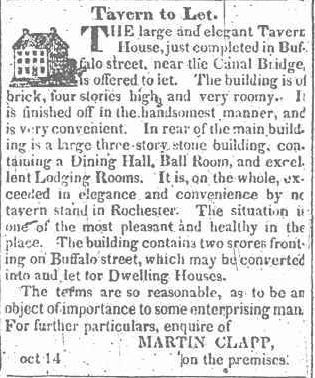 |
| "Tavern to Let," Rochester Daily Advertiser and Telegraph, October 14, 1829, Page 2. |
Later historical accounts were unaware of Clapp's 1829 advertisement and gave various dates for the building's construction ranging from 1826 to 1828, with no source provided. The building still has a prominent "1826" sign facing West Main Street. These later accounts also note that the building cost about $25,000, again with no reference. An 1852 newspaper article references an early court case against Clapp concerning the building and an 1868 memoir states that the building was highly speculative and resulted in Clapp's financial ruin. Monroe County Court records reveal several lawsuits that Clapp was involved in from 1834 to 1842, most involving foreclosures on his properties including the hotel building..
The first known occupant of the building was Rev. Gilbert Morgan's Rochester Institute for Practical Education that occupied the building for about a year starting in May 1831. Female seminaries or academies were conducted from 1832 to 1834 by the Misses Black and Sarah T. Seward. Miss Seward's Female Seminary moved to Spring street in 1834 and then to a new building on Alexander in 1835.
Several early maps show the property, as shown below.
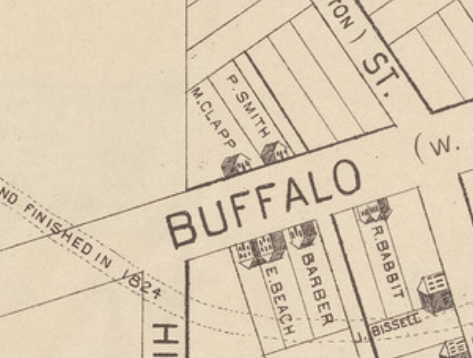 |
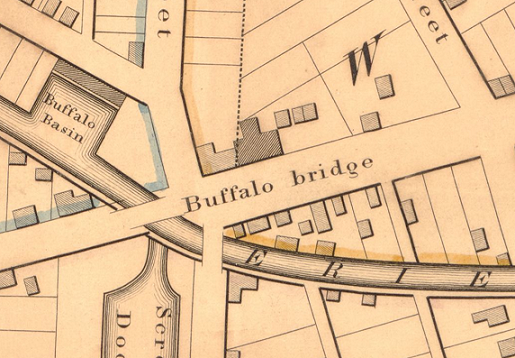 |
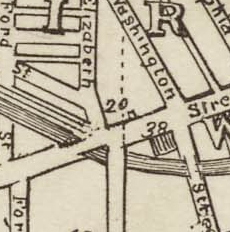 |
| Map of the village of Rochester in 1820: as drawn by the publisher from actual survey published by Horatio N. Fenn (1856) | Map of Rochester from a correct survey by Valentine Gill (1832) | Map of the City of Rochester, drawn for O'Reilly's Sketches by S. Cornell. (1838) |
The notable artist J.L.D. Mathies moved to Rochester in 1823 and managed the Arcade House and Clinton House, where he displayed paintings by himself and others.
| Paintings by J.L.D. Mathies | |||
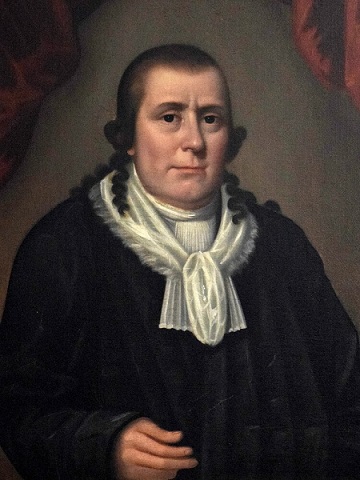 |
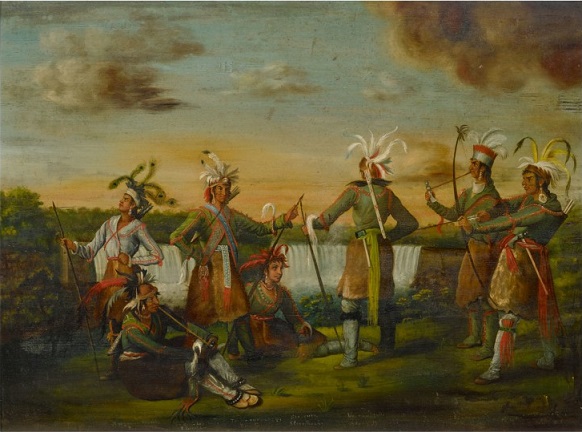 |
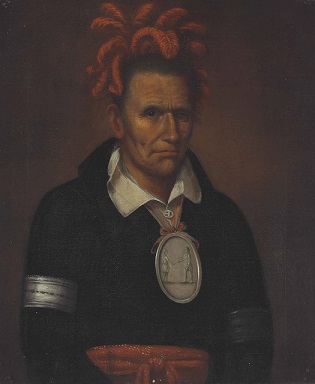 |
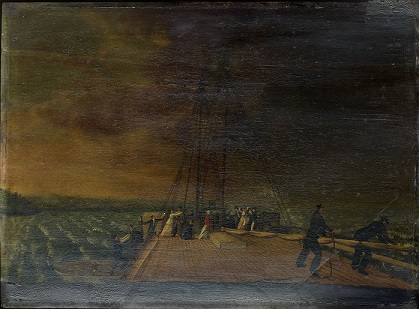 |
| Jemima Wilkinson/Publick Universal Friend (1816) | Seneca Veterans of the War of 1812 (1819-1820) | Red Jacket (1820) | Wreck of the Walk-in-the-Water (1821) |
Mathies opened the City Hotel in this building on April 25, 1834 and received a tavern license in July. John P. Cushman foreclosed on Clapp's mortgage, shortly after Mathies had opened the new hotel. Cushman sold the property including the building to Everard Peck in May 1834 but bought it back the same day. He then sold the property to Frederick Whittlesley (later elected the first vice-president of the University's Board of Trustees), whose mortgage was foreclosed in 1842.
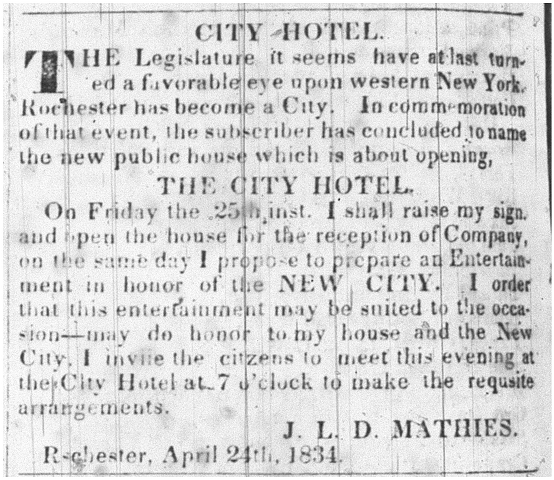 |
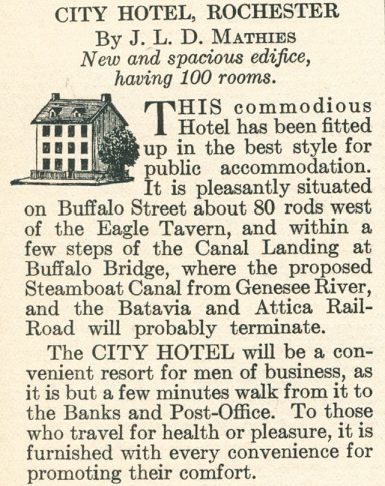 |
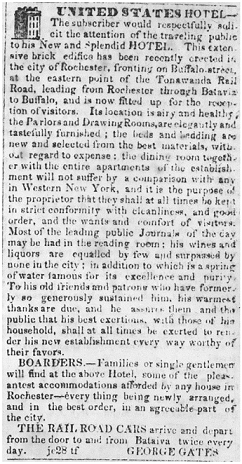 |
| Rochester Daily Democrat, April 24, 1834, page 2 | "In the Looking-Glass of 1834," by Major Wheeler C. Case, Centennial History of Rochester, New York 2:155 (1932) | "United States Hotel," Rochester Daily Democrat, August 28, 1837, Page 1. |
Mathies died of consumption on November 25, 1834 and the hotel was renamed the United States Hotel in June 1837 by new proprietor George Gates, about whom little is known. The Tonawanda Railroad opened in May 1837 and terminated just across Elizabeth street from the hotel, which became the train depot. The Tonawanda Railroad requested permission to reroute their line through Rochester to connect with the Auburn and Rochester Railroad's station on Mill Street near the Genesee River. A law in March 1844 approved this, and the work was completed in November 1844. By early 1844 the building had become a temperance house, but the relocated railroad caused the hotel's fortunes to decline rapidly. The property was sold in August 1844 to George F. Talman, who was also an agent of the Farmers' Bank and Loan Company. By early 1845 it had become a mutual boarding house and was later described as a "second-rate" hotel, although the only one in the city operated on temperance principles. The facility was renamed the Hamilton House by May 1850 and was "undergoing a thorough repair, from summit to base, which will refit it for one of the most commodious boarding houses in the city."
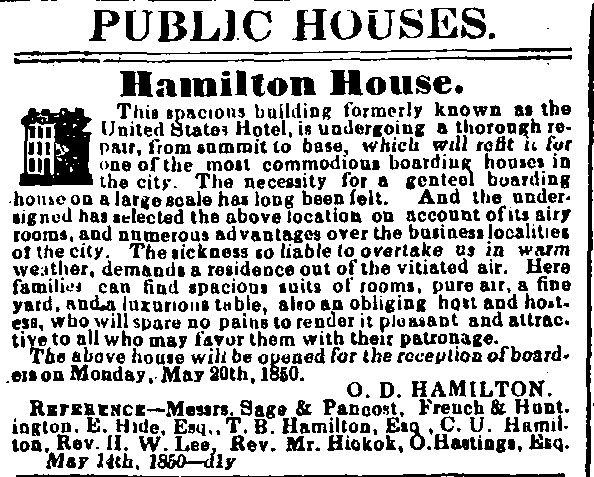 |
| Rochester Daily American, May 15, 1850, Page 1. |
The same day that this advertisement appeared (May 15, 1850), the trustees of the new University of Rochester voted to "hire the United States Hotel for three years on the terms proposed by Mr. Tallman, the receiver of said property, namely $800 pr. year, and make such repairs as necessary for the accommodation of the institution." The trustees in December decided "to purchase the property, for $9,000 from George F. Talman of New York City" for $3,000 in cash and a $6,000 mortgage that was probably held by Talman, who was vice-president of the Farmers' Loan and Trust Company of New York City. The deed was dated March 1, 1851. Classes began in November 1850 and continued until 1861, when the University moved to its new home in Anderson Hall on the Prince Street Campus.
 |
| Photo credit J. Adam Fenster |
The only known image of the building while occupied by the University is this 1853 lithograph:
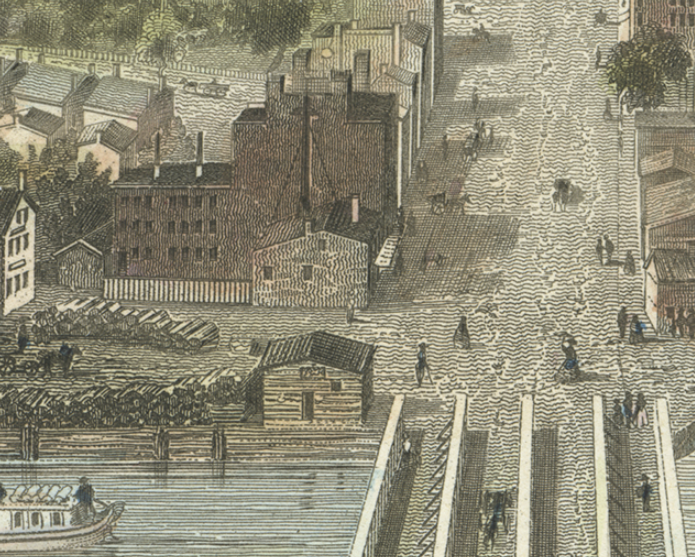 |
| Rochester,
by John William Hill, lithograph published by Smith Brothers,
New York. (click on image for full view) |
Carpenter's Collegiate Institute, headed by 1852 UR Graduate Elisha M. Carpenter, occupied the building from 1864 to 1867 and had George Eastman as a student in 1865. Carpenter moved the school to a new location shortly after the University sold the building to Giles B. Rich in May 1867.
On June 17, 1928 the Associated Alumni dedicated a bronze tablet on the building to honor its role in the University's founding, This tablet has since disappeared although the building is still standing at 212-224 West Main Street in Rochester.
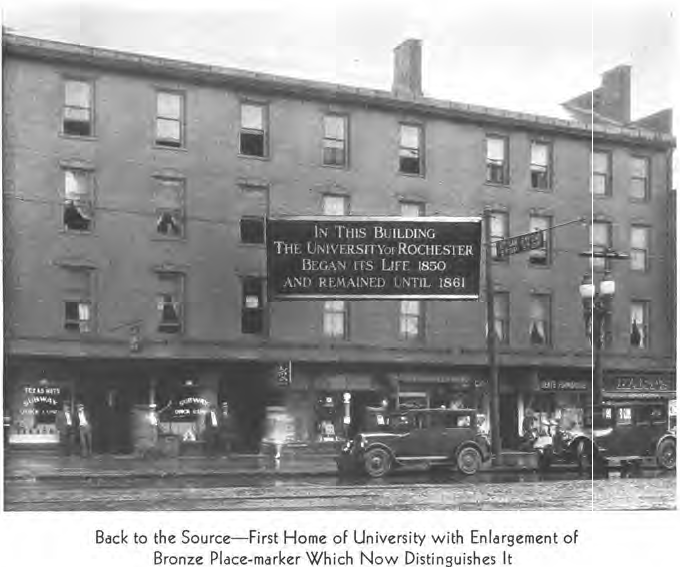 |
| The University of Rochester: A Story of Expansion and its Background, by Hugh A. Smith, Page 29 (1930) |
References
and Timeline
1820 "Sheriff's Sales," Rochester
Telegraph, November 14, 1820, Page 3.
By virtue of an execution issued out of the county court, and to be
delivered, against the goods and chattels, lands and tenements of Martin
Clapp, I have seized and taken lot No. 223, in the village of Rochester,
agreeable to the plan of said village, which I shall expose to sale at the
house of John G. Christopher, in said village, on the 26th day of December
next, at one o'clock P.M. Dated Nov 14, 1820. For P. Adams, Sh'ff.
S. Close, dep.
1820 Deed
from William Fitzhugh and Ann Fitzhugh his wife to Martin Clapp,
November 25, 1820, five shillings, book 1, page 367
All that Lot or portion of ground in the Village of Rochesterville Genesee
County, Town of Gates, fronting on Buffalo Street, known and d1st1ngu1ehed
in the plan or plot of said Village by Lot number Two hundred and twenty
three. Containing one quarter of an acre, be the same more or less.
1820 Map
of the village of Rochester in 1820: as drawn by the publisher from
actual survey published by Horatio N. Fenn (1856) | also here
|
Property of M. Clapp, lot 223 on Buffalo Street at west edge of the
Hundred Acre Tract
1822 Deed
From Martin Clapp to Phelps Smith, January 12, 1822, $50, book 1,
page 374
East portion of lot 223.
1827 A
Directory of the Village of Rochester, March 1, 1827.
Page 10: Householders - Clapp, Martin, Mason, Buffalo-st.
1827 "Soda
Water," Rochester Democrat and Advertiser, November 1, 1827,
Page 1.
J.L.D. Mathies, March 27, 1827
1828 Rochester
in 1827. With a map of the village, by Jesse Hawley and Elisha
Ely, February 1828.
Page 146: Three large Hotels are now building, besides the several
already occupied; and another to surpass in convenience and beauty, all
which have preceded it, is designed to be located on Buffalo-street, near
Buffalo Bridge, and completed in the course of the present year.
1828 Mortgage Martin Clapp to John P. Cushman, May 1, 1828, $9,000, Mortgage book 6, page 6
1828 Deed
From Richard Gorsline to Martin Clapp, July 12, 1828, $200, book 16,
page 139
Triangle-shaped section of land on west side of lot 223.
1828 Rochester
Daily Advertiser, October 3, 1828, Page 3.
Notice is hereby given, that all the notes and book accounts of Alexander
and Leveret Casson, have been assigned to Jonathan Child, Chas R. Ward,
and Martin Clapp. All persons indebted to the said Cassons, either by note
or account, will please call on the subscriber, who is authorised to
settle the same; and all demands not settled on the 1st Oct. next, will be
put in suit. sep 17; Jona. Child
1829 "Arcade," by J.L.D. Mathies, The Craftsman 1(23):185 (July 14, 1829)
1829 "Tavern
to Let," Rochester
Daily Advertiser and Telegraph, October 14, 1829, Page 2.
The large and elegant Tavern House, just completed in Buffalo street, near
the Canal Bridge, is offered to let. The building is of brick, four
stories high, and very roomy. It is finished off in the.handsomest
manner, and is very convenient. In rear of the main building is a large
three story stone building, containing a Dining Hall. Ball Room, and
excellent Lodging Rooms. It is, on the whole, exceeded in elegance
and convenience by no tavern stand in Rochester. The situation is
one of the most pleasant, and healthy in the place. The building
contains two stores fronting on Buffalo street, which may be converted
into and let for Dwelling Houses.
The terms are so reasonable, as to be an object of importance to some
enterprising man. For further particulars, enquire of MARTIN CLAPP,
on the premises
oct 14.
1831 "Our
Public Houses," Rochester Gem 3:39 (July 2, 1831)
Eagle Tavern, Clinton House, Rochester House, Mansion House.
1831 "Rev Gilbert Morgan, Principal of Rochester Institute for Practical Education," Rochester Republican, July 26, 1831, Page 3.
1831 "The Rochester Institute for Practical Education," Rochester Republican, November 6, 1831
1831 American
Annals of Education and Instruction for the year 1831
1(10):489-490 (October 1831)
The Rochester Institute of Practical Education
1831 "The Rochester Institute for Practical Education," Rochester Daily Advertiser, November 17-18, 1831
1832 An act to incorporate the Rochester Institute of Practical Education, April 14, 1832.
1832 "Female Education,"
Rochester
Republican, April 17, 1832, Page 3.
Letter of recommendation for the Misses Black from Emma Willard of the
Troy Female Seminary.
1832 An act to incorporate the Tonawanda Rail-Road Company. April 24, 1832.
1832 Map
of Rochester from a correct survey
Shows building that became City Hotel and United States Hotel on Buffalo
Street.
1833 "The
Clinton House," Rochester
Daily Advertiser, January 18, 1833, Page 3.
J.L.D. Mathies, June 27, 1832
1834 "City
Hotel," Rochester Daily Democrat, April 24, 1834, Page 2..
J.L.D. Mathies, owner announces opening
1834 Deed from John P. Cushman to Everard Peck, sale of Martin Clapp's Land, $600, May 5, 1834, book 29, page 241.
1834 Deed from Everard Peck to John P. Cushman, May 5, 1834, $1.00, book 29, page 243.
1834 "J.L.D.
Mathies," Rochester Daily Democrat, July 26, 1834, Page 2-2.
Granted tavern License
1834 John Lee Douglas “J.L.D.” Mathies (1780-1834) grave in Mt. Hope Cemetery
1834 "Death of J.L.D. Mathies," Rochester Daily Democrat, November 26, 1834, Page 2
1834 Charter
and Directory of the City of Rochester: Also Statistics, Population,
City Officers, Publick Buildings, Institutions, Fire Department,
&c., &c
Page 2: Principal Publick Houses. City Hotel, Buffalo-st. Keeper -
J.L.D. Mathies
Page 28: Clapp, Martin, mason, Buffalo-st.
Page 80: Seward, Jason W., Rochester Female Seminary, Spring-st.
1835 Deed from Martin Clapp by Ezra M. Parsons Late Sheriff of the County of Monroe to John P. Cushman, October 24, 1835,
1835 Deed from John P. Cushman to Frederick Whittlesey, November 6, 1835, $11,000, book 33, page 301.
1835 Mortgage Frederick Whittlesey to John P. Cushman, November 6, 1835, $10,000, Mortgage book 16, page 425
1837 "Completion
of the Tonawanda Rail Road From Rochester to Batavia," Rochester
Daily Democrat, May 11, 1837, Page 2.
The Morning Train will leave the Depot at the City Hotel every morning at
6 o'clock, and arrive at Batavia at 8. The stages will leave Batavia
at 9 and arrive at Buffalo from 3 to 4 P.M.
1837 "United
States Hotel," Rochester Daily Democrat, August 28, 1837,
Page 1.
The subscriber would respectfully solicit the attention of the traveling
public to his New and Splendid HOTEL. George Gates.
1838 Directory
of the City of Rochester for 1838
Page 10: United States Hotel, corner of Buffalo-st. and Rail Road,
Geo. Gates
1838 Settlement
in the West: Sketches of Rochester by Henry O’Reilly
Page 376: United States Hotel by George Gates and engraving of the
hotel on pages following.
1838 Map
of the City of Rochester, drawn for O'Reilly's Sketches by S.
Cornell.
Shows United States Hotel (#20) and Tonawanda Railroad terminus across
Elizabeth street from hotel.
1841 King's
Rochester City Directory and Register 1841
Page 19: Hotels. United States Hotel, 174 Buffalo, Proprietor
Geo. Gates.
1842 Deed from Frederick Whittlesby by John C. Cash, Master in Chancery, to John Duer, April 26, 1842, $10,500, book 58, page 92.
1842 "In Common Council,"
Rochester
Daily Democrat, May 5, 1842, Page 2-5
May 3, 1842. Petitions. Communication of the Tonawanda
Railroad Co. for permission to continue their railroad so as to connect
with the Auburn and Rochester Railway.
1842 "U.S. Hotel Burned," Rochester Daily Advertiser, July 28, 1842, Page 2-3
1843 "Martin Clapp died," Rochester Daily Advertiser, April 25, 1843, Page 2-5
1843 "Martin Clapp died,"
Rochester
Daily Democrat, April 26, 1843, Page 2
In this city, on the 22d inst., Mr. Martin Clapp, an old resident, aged 48
years
1843 Martin Clapp (-1843) Grave in Mt. Hope Cemetery
1844 An act to authorize the Tonawanda Railroad Company to connect their railroad with the Auburn and Rochester Railroad in the City of Rochester, March 19, 1844.
1844 A
Directory and Gazetteer of the City of Rochester for 1844,
March 1844.
Page 30: Hotels. U.S. Hotel, (Temperance,) 174 Buffalo,
Proprietor J.R. Parker.
1844 Deed from John Duer and wife of the City of New York to George F. Talman, August 22, 1844, $18,000, book 66, page 223
1844 Auburn
Journal and Advertiser, November 27, 1844, Page 2.
The connecting link between the Auburn and Rochester and Tonawanda
Rail-ways has been completed; a train of cars passed over on Tuesday last.
1845 "A
Novel Plan," New York Tribune, April 25, 1845, Page 4.
The United States Hotel of this city has been taken, as we understand, by
a company of ten individuals for joint occupancy, as a Mutual Boarding
House, at a rent of seven hundred and fifty dollars. Boarders are
taken, some as low as twelve shillings per week, on the old plan. But, the
peculiarity of the plan is, for the associated families to obtain, at a
far less cost for house rent, fuel, servants, time, &c. greater
domestic privileges than before, better and larger rooms, a more varied
table, an exemption from the annoyances of housekeeping on a small scale,
and the opportunity of superior social privileges.
The System is somewhat novel–somewhat borrowed from Fourier. We wish it
may be fairly tested. The wastefulness of the present system is hard to be
endured. And yet, attempts to improve upon it have almost
universally failed–failed for want of allowance for friction, in
other words, for the imperfection of human nature. These undertakers we
believe to be practical mechanics; men who understand what they are about,
and seldom leap in the dark. We hope all good things for them. [Rochester
American.
1845 "New
Mode of Housekeeping," Pennsylvania
Telegraph (Harrisburg, Pennsylvania), May 7, 1845, Page 2.
Something new in the way of mutual house-keeping, or
hotel-keeping, has been put in practice in Rochester, N.Y. The United
States Hotel there has been taken by a company of ten individuals, for
joint occupancy, as a Mutual Boarding House, at a rent of seven hundred
and fifty dollars. Boarders are taken, some as low as twelve shillings per
week, on the old plan. But the peculiarity of the plan is, for these
associated families to obtain, at a far less cost for house rent, fuel,
servants, time, &c., greater domestic privileges than before, better
and larger rooms^ a more varied table, &c. Not a bad idea, if the
families can avoid dissensions.
1845 "U.S.
Hotel - Buffalo St.," Rochester
Daily Democrat, June 26, 1845, Page 2.
This House, having "gone down," in consequence of the removal of its
railroad facilities, has recently been taken by a company, chiefly
mechanics, for the purpose of keeping a Boarding House on a larger scale
than usual, and at a cheaper rate for the same accommodations. In
addition, to the Boarding department, this House presents to the public
the accommodations of at least a second rate Hotel, and will be in
readiness to entertain parties on the coming 4th of July. It is the
only House in the city (known to us) that is kept on the strictest
Temperance Principles.
1845 Canfield
& Warren's Directory of the City of Rochester, for 1845-6.
August 1845.
Page 166: United States Hotel, 174 Buffalo
1850 "Hamilton
House," Rochester Daily American, May 15, 1850, Page 1.
This spacious building formerly known as the United States Hotel
1850 "Rochester
University," New-York Daily Tribune, September 24, 1850,
Page 7.
This institution, we learn from the Daily Advertiser, will be
opened on the 1st Monday of November. The following Professorships
have been established:
"Moral and Political Science,"
"Latin Language and Literature," Prof. John F. Richardson,
"Greek Language and Literature," Prof. A. C. Kendrick, D.D.
"Natural Sciences," Prof. Chester Dewey, D.D.
"History and Belle Letters," Prof. John H. Raymond.
"Hebrew and German Languages," Prof. Thomas J. Conard, D.D.
"Mathematics and Natural Philosophy," Prof. S. S. Green
The Advertiser adds, the price of tuition has been fixed at $30
per annum. The advantages to be enjoyed students in this locality, as
enumerated by the officers, are many, and will doubtless tend largely to
increase the patronage of the Institution. we understand that thd
commodious brick building on Buffalo st. formerly known as the United
States Hotel, has been secured for the temporary use of the University. It
is elegantly situated, and we think it would accommodate nearly two
hundred student. The University of Rochester, of which there had
been so much said, seems now to have assumed a tangible form, and our
citizens will shortly see it in the full tide of successful operation.'
The names of the Executive officers of the University have not yet been
announced. The offices of the Board of Managers are, John N. Wilder,
President, and Wm. N. Sage, Secretary.
1850 "University
of Rochester," New-York Daily Tribune, September 26, 1850,
Page 4.
We are pleased to see that a noble effort is being made by the Baptist
Denomination to do their share of the Collegiate Education of the State.
The position they have selected as the location of a large University has
no superior in the State of New-York. Rochester is a rural, beautiful and
growing city. It it natural center fur the large section between Syracuse
and Buffalo. Its surroundings are filled with an enterprising and
intelligent farming population Its citizens are mainly of New England
descent and favorable of course to education. The interest of the county
in which Rochester is situated, has been expressed by a subscription from
parties entirely responsible, amounting to about seventy-five thousand
dollars. Fifty thousand dollars is expected from New-York and
Brooklyn. From what we know of the enterprise and pecuniary ability of
Baptists in this city and vicinity, we think this sum will be easily and
speedily secured, and a great and useful institution of learning be given
to the western section of the State by a body of Christians who have
hitherto been somewhat delinquent in this department of Christian
benevolence. The friends cf the University hold a meeting this evening at
7½ o'clock in the Oliver-Street Church. We hope it may be well attended.
1850 "University of Rochester - Opening of the College," Rochester Daily Democrat, November 6, 1850, Page 2.
1850 University bought the building on December 2, 1850, 1891 Regents Report. The deed from Talman was dated March 1, 1851.
1851 "University
Buildings," The Annunciator 2(1):3 (January 1, 1851)
Under the whole is a large basement used for cellars, and a refectory for
such students as choose to board with the janitor. The rooms of the
literary societies are on the lower floor of the main building, and are
being tastefully decorated and conveniently and elegantly furnished.
Adjoining these rooms are the reading-room and the library. On the
opposite side of the hall from the reading-room is Professor Raymond's
recitation room. On the second floor of the main building are the
recitation rooms of Professors Conant, Maginnis, Richardson, Dewey, Smith,
and Kendrick. All these rooms are complete; have comfortable seats, window
shades, carpets, etc. On the second floor of the main building is the
trustees' room of the Education Society. The third and fourth stories of
the main building are occupied by students. The rooms in the wing are
principally occupied by students. In the wing is Professor Kendrick's
valuable classical library. Professor Raymond, Dr. Conant, and others have
libraries of more or less value in different rooms of the front building.
The chapel is a light and pleasant room 70 feet long and 30 in width. On
the east side is a carpeted rostrum. On the rostrum is a suitable
reading-desk, and chairs for nine professors. Comfortable seats have been
provided for the students, and for morning prayers and evening lectures no
more convenient or appropriate chapel is needed for the present. The
materials have been furnished for a geological cabinet, and a museum for
whatever is rare and curious will soon be commenced. Rooms will be
appropriated for both of these purposes.
1851 Deed from George F. Talman of the City of New York to the Trustees of the University of Rochester, March 1, 1851, $9,000, book 94, page 232.
1851 Mortgage from the University of Rochester to George F. Talman, March 1, 1851, $6,000, mortgage book 53, page 315.
1852 "The
Three Eras of Buffalo Street," Rochester
Daily Democrat, October 4, 1852, Page 2.
Era No. 1 - Or from the opening of Buffalo street in 1814, to the time of
opening the Burying Ground upon it in 1822 - 8 years.
1852 "The
Three Eras of Buffalo Street," Rochester
Daily Democrat, October 8, 1852, Page 2.
Era No. 2 - Or from the opening of the Burying Ground in 1822, to
the completion of the City Improvements in 1836 - 14 years.
Cross over to the U.S. Hotel, so long in law; ------ vs. Clapp
1852 "The
Three Eras of Buffalo Street," Rochester
Daily Democrat, October 12, 1852, Page 2.
Era No. 3 — Or from the so-called Improvement of the City Council in
1836, to a broken and sinking condition in 1852.
1853 Rochester,
by John William Hill, lithograph published by Smith Brothers, New
York. | another
copy |
This view is looking east down Buffalo Street, United States Hotel is the
taller building just beyond the bridge over the canal.
1856 Discharge of mortgage from the University of Rochester to George F. Talman, July 17, 1856, Discharge of Mortgage book 20, page 92.
1861 Mortgage from the University of Rochester to the Monroe County Savings Institution, January 22, 1861, $4,000 mortgage book 101, page 198.
1864 "Collegiate
Institute," Rochester Union and Advertiser, October 15,
1864, Page 1
This school will re-open on Wednesday next, Oct 12, the middle of the
first term.
1864 "The
New Collegiate Institute," Rochester Union and Advertiser,
October 15, 1864, Page 2
Re-opens the Collegiate Institute in the University building
1864 Sixteenth
Annual Report of the Western House of Refuge for Juvenile Delinquents,
December 1, 1864
Page 8: In October last, Mr. Elisha M. Carpenter, who for nine years
previous had discharged with fidelity and ability the duties of principal
of the senior department of the school, resigned his position in order to
open a collegiate institute in this city.
1865 Letter from George
Eastman to his Uncle Horace Eastman, November 19, 1865
"I go to school to Mr Carpenter in the old University building near the
corner of Bufflo and Elizabeth Streets he has about seventy scholars and
it is the best private school for boys in the city. I study Algebra.
Geography. Arrithmetic. Reading and Spelling. school is called at quarter
of nine we have a recess of 5 minutes at half past ten and fifteen minutes
at half past twelve oclock then school is dismissed at two.".Reprinted in
"Early
Letters of George Eastman to Horace H. Eastman, his Uncle," Genesee
Country Scrapbook 5(1):2-14. (1954)
1856 Discharge of mortgage from the University of Rochester to Monroe County Savings Institution, October 23, 1866, Discharge of Mortgage book 23, page 137.
1867 The
New York State Business Directory and Gazetteer
Page 970: "Carpenter's Collegiate Institute, E.M. Carpenter, Principal
1867 "Collegiate
School," Rochester Union and Advertiser, March 30, 1867,
Page 2.
We learn that Mr. Carpenter has removed his school for boys to the
spacious hall in the Marble Block, 73 Main street.
1867 Deed
from Trustees of the University of Rochester to Giles B. Rich of
Lafayette, Indiana, May 20, 1867, $10,000, book 216, page 40.
Being the same premises formerly known as the City Hotel Building, and
lately as the University of Rochester.
1868 Desultory
notes and reminiscences of the city of Rochester: its early history,
remarkable men and events, strange revelations of the murders,
mysteries and miseries, casualties, curiosities and progress of this
young and growing city, for the last 50 years, by an
Octogenarian. [Lyman Barker Langworthy]
Page 14: A building of some remark on Buffalo street, is the large
structure lately known as the University, built by Martin Clapp in
1828, and thought in early days to be a wild speculation, as it did
eventually turn out — ruining the builder. It was afterwards kept by J. L.
D. Matthies as the United States Hotel, at the front door of which
the Tonawanda Railroad, as it was then called, ended and landed
its passengers, which is now one portion of the great Central New York
road.
ca. 1870s Picture of United States Hotel building
1883 "George F. Talman," The New York Times, June 12, 1883, Page 4.
1884 Semi-centennial
History of the City of Rochester: With Illustrations and Biographical
Sketches of Some of Its Prominent Men and Pioneers, by William
Farley Peck
Page 304: In about the same period of time Phelps Smith, for the
purpose of aiding his sister in a good work, erected near the rear end of
his dwelling-house, and at the rear or westerly end of his lot on North
Washington street, a schoolhouse of hewed logs. It was about twenty feet
square. An alley, yet remaining there, led from Buffalo street to the rear
end of the lot and school-house. This commendable
enterprise of Mr. Smith was rewarded with success, and Miss Smith's
school flourished. The children of Lyman B. and W. A.
Langworthy, of Deacon Oren Sage and of many other residents of the
vicinity attended the school. Three of the pupils are
now Dr. H. H. Langworthy and William N. Sage, of Rochester, and John T.
Langworthy, of Washington, D.C., first assistant controller of the
currency. Miss Smith subsequently married Martin Clapp, who nearly
sixty years ago was the builder of the United States Hotel, which is yet
standing on the north side of West Main street near the corner of
Elizabeth street. Within a few years after its completion it was
successively used for a hotel, for the Tonawanda railroad depot, for a
manual labor institute, for Misses Blacks' and also Miss Seward's female
seminaries and then for the University of Rochester. It is of the
experiment in the United States Hotel building of a manual labor school
for Rochester, about the year 1828, that brief mention is next to be made.
The school was designed for the higher education of young men, and for a
time it had a goodly number of students. A few hours each day school
exercises were suspended and the students applied themselves, and whatever
mechanical skill they had or could acquire, to making barrels for the
flour mills of Rochester. Rev. Gilbert Morgan, an accomplished scholar,
was the principal. The standard of scholarship in the institution was
high. Although it was a laudable effort to assist young men of limited
means to obtain an education, and much interest was manifested in the
institution by many citizens, it did not succeed, and Mr. Morgan
subsequently engaged for a time in teaching in the High school on the east
side of the river. Afterward he removed from Rochester to South Carolina,
where he continued to reside for many years.
Page 305: During the period from about 1830 to 1834 there were two
notable schools established on the west side of the river for the higher
education of young ladies. The first was the school of the Misses Black,
which was commenced about 1830, in the Sill building on the west side of
South Fitzhugh street, near the corner of West Main street, and afterward
removed to the United States Hotel building. The Misses Black were
English-Canadian ladies. One or both of them had been educated at Miss
Willard's famous Troy female seminary. Both were well qualified as
teachers and were in all respects accomplished ladies. Their school was
attended by many then young ladies who in after years graced society in
Rochester and in other places. Some of the peculiarities of the school in
matters of etiquette and methods of instruction were English rather than
American, but the school was a flourishing one while it continued and was
satisfactory to its patrons. Marriage, again, as in so many schools having
female teachers, occasioned an interruption to the Misses Blacks' school.
The elder Miss Black early in 1833 married a Canadian gentleman and
returned to Canada to reside.
The other school above alluded to and immediately succeeding the Misses
Blacks' school was that of Miss Sarah T. Seward, afterward Mrs. Gen. Jacob
Gould, who was also a graduate of the Troy female seminary, and who came
to Rochester from Lebanon Springs in this state early in March, 1833, and
almost immediately opened a school in the United States Hotel building.
There had also come from the Troy female seminary Miss Sayles, afterward
Mrs. William S. Bishop. Miss Sayles became the assistant of Miss Seward,
as she had been of the Misses Black. Miss Seward's school speedily
achieved great success. After continuing in the United States Hotel
for one year it was removed to the large stone building at the corner of
Plymouth avenue and Spring street, the present site of the First
Presbyterian church. During its continuance at that place for nearly two
years, and till its removal to Alexander street in the autumn of 1835, it
continued to flourish, and there followed an awakening of the people of
Rochester to an appreciation of the value of higher female education. As
the result of this awakening, two new female academies were projected and
new buildings for them were erected in 1835 and 1836. Auspicious and
favoring circumstances attended both institutions and both were
meritorious. One was Miss Seward's Alexander street female seminary, the
building for which was completed and the school opened in October, 1835.
1891 Deed
from Giles B. Rich to Willard G. Rich, April 8, 1891, $1.00, book
520, page 494.
Being the same premises formerly known as the City Hotel and then the
United States Hotel afterwards owned and occupied by the University of
Rohester.
1893 "Memories
of Village Days: Rochester 1822-1830," by Jesse W. Hatch, Read
before the Rochester Historical Society December 8th, 1893. The
Rochester Historical Society 4:235-247 (1925)
Page 243: North of the Mansion House on Carroll Street was the
Monroe Garden kept by the late George Gates, who subsequently conducted
the City Hotel on Buffalo Street at the terminus of the Rochester and
Tonawanda R. R., now known as the old University Building, which was built
about 1827 or 1828.
1895 Orlando
Dyer Hamilton (1817-1895) Grave in Mt. Hope Cemetery.
Proprietor of the Hamilton House in 1850.
1895 A
History of the City of Rochester from the Earliest Times, by
the Rochester Post Express.
Page 256: Jason W. Seward. In 1833 he came to Rochester and
with his sister, Sarah T. Seward, opened a school for young ladies in the
United States Hotel building on Buffalo (West Main) street. The
school was so successful that in 1835 a building was erected for it on
Alexander street, where the Seward seminary was long conducted.
1895 Landmarks
of Monroe County, N.Y. by William F. Peck
Page 125: As all things grow, Rochester outgrew its village
condition, and on April 28, 1834, the act of incorporation of the city of
Rochester, containing its charter, was passed. This action was not
premature, for the the population and the volume of business fully
warranted it. The number of inhabitants was 12,289, there were thirteen
hundred houses, fourteen churches or meeting-houses, nine hotels---the
Eagle, the Rochester, the Clinton, the Mansion, the Monroe, the Arcade,
the Franklin, the City and the Rensselaer
1896 "Giles
Blodgett Rich," Democrat and Chronicle, April 7, 1896, Page
14.
An early resident of Rochester, died at his residence on East Avenue
1902 Elisha M. Carpenter (1831-1902) grave. Graduate of the University of Rochester 1852; Principal of Carpenter's College Institute in 1864-1867
1902 "Obituary of Elisha M. Carpenter," New York Observer, February 13, 1902, Page 212.
1912 "City
Might Have Been Clappville," Democrat and Chronicle,
September 19, 1912, Page 13.
Martin Clapp was pioneer. He erected the old United States Hotel,
which was destroyed by fire many years ago.
ca. 1916 United States Hotel building
1922 "Rochester
- Background of Its History," by Raymond H. Arnot, Publications
of the Rochester Historical Society: Publication fund 1:93-111
(1922)
Page 108: United States Hotel
1925 Rochester
and Colgate : historical backgrounds of the two universities,
by Jesse Leonard Rosenberger, April 1925
Page 124-126: The building was constructed of brick and stone, in 1826, at
a cost of about $25,000. It was L-shaped and four stories high. It had a
frontage of 100 feet on Buffalo Street (now Main Street West), being on
the north side of that street, a little east of Elizabeth Street. The wing
which extended back from the west end of the main part of the building was
also of considerable length and capacity. The building was used first for
hotel purposes, and afterward, at one time and another, it was, as a whole
or in part, used for a manual training school, for two different schools
for girls, and for a railroad station.
The whole building, according to one account, contained a convenient
chapel, two halls for the two literary societies, fourteen well-lighted
and well-finished rooms, convenient in all respects for recitation,
lecture, library, and reading-rooms; and sixty-five smaller rooms,
affording accommodations for the same number of students. In connection
with the building, it was further said, there were grounds sufficiently
spacious for the comfort and convenience of the members of the University.
1925 Rochester
at Seventy-five: Address Before Iota Chapter, Phi Beta Kappa,
June 14, 1925, by John Rothwell Slater
Page 14: For the Age of Foundation I will take you first out West
Main Street, between North Washington and Elizabeth Streets, where the old
United States Hotel stands dishonored and neglected in shabby old age,
with no tablet to mark the spot where the University of Rochester began.
The ground floor, cut up into small shops, retains no trace of the old
chapel, a room seventy by thirty feet, where, we are told, on November 5,
1850, the formal opening exercises were held. Likewise the old classrooms
on the second floor have been cut up into tenements, so that only the
arched hallways and worn wooden stairways afford any pathway for the
imagination, as we try to picture those old-time teachers and students
passing from one grade of Parnassus to another. But on the upper floors,
where the boys lodged (notwithstanding the determination of the trustees
to maintain no dormitory), there may still linger the ghost of a freshman,
or the echo of some nocturnal diversion. When you make your pilgrimage
step around through the alley to the rear of the building, where the
courtyard of the old inn, erected in 1826, still preserves something of
the gray dignity that has vanished from the street front. It is not easy
to repeople this old caravanserai with scholars, and it retains little of
the odor of sanctity, but the fact remains: there we were born, and you
may still see the cradle.
1927 Rochester,
the making of a university, by Jesse Leonard Rosenberger, with
an introduction by President Rush Rhees.
Pages 28-32: The "first duly called and notified regular meeting of
the trustees" was held on September 16, 1850, in the committee room of the
First Baptist Church of Rochester. The organization of the board, "under
the charter," was perfected by the unanimous election of John N. Wilder,
president; Frederick Whittlesey, vice-president; William N. Sage,
secretary; and Edwin Pancost, treasurer.4 (On December 9, 1850, Mr.
Pancost offered his resignation as treasurer, which the executive board
accepted. That was followed by the appointment of William N. Sage as
treasurer, after which Mr. Sage rendered service as secretary and
treasurer for practically half a century.) A resolution was then passed:
"That the proceedings of the informal meeting held in Rochester May 15,
1850, be approved and ratified by this board." What was to be called the
"Executive Board of the University of Rochester" was created, to be
composed of nine of the trustees, three to be elected annually after the
first year. The first members of that board were John N. Wilder, R. S.
Burrows, E. F. Smith, Edwin Pancost, E. Huntington, D. R. Barton, Everard
Peck, F. Whittlesey, and William N. Sage, and most or all of them were
kept on the board as long as they remained trustees, which meant many
years for several of them. To that board was committed the immediate
superintendence of the university, with power to enact and enforce every
regulation required for the immediate good of the university, and, in
general, to take such measures as might to them seem expedient for the
well-being of the institution.
The trustees directed the executive board "to hire the United States Hotel
for three years on the terms proposed by Mr. Tallman, the receiver of said
property, namely $800 pr. year, and make such repairs as necessary for the
accommodation of the institution."
It was fortunate for the university that this building could be obtained
for it, and on moderate terms, too, for after an expenditure of about
$1,500 only, for repairs, changes, and necessary furnishings, it supplied
at once, and for a decade, all that the university absolutely needed in a
building. In fact, it not only met the early requirements in that respect
of the university, but also, from the same date, those of the Rochester
Theological Seminary, for the use of which the university sublet a part of
the building.
The building was on the north side of Buffalo Street (now Main Street
West), a little east of Elizabeth Street, and near the Erie Canal. It had
a frontage of one hundred feet on Buffalo Street and a capacious wing
which extended back from the west end of the main part, the whole
structure being four stories in height. When ready for use by the
university, there were on the lower floor of the main part a commodious
chapel, rooms for two literary societies, a library and reading-room, and
one recitation room; while on the second floor there were all the other
rooms of good size needed for recitation and lecture purposes. On the
third and fourth floors of the main part and in the wing generally there
were about sixty-five or seventy rooms suitable for the accommodation of
that number of students. Besides, there was a basement under the whole
which provided rooms for the janitor and his family; a dining-hall to be
conducted by him for such students as might wish to take their meals
there; and cellars.
The executive board ordered purchased, for use in the building, five pine
tables, six arm chairs, one hundred common wooden chairs, thirty settees
for the chapel, seven box stoves, and seven boxes for wood. It also
approved of an expenditure of $25.81 for lamps, and approved a bill for
carpeting. The rostrum in the chapel was carpeted; while the recitation
rooms, it was said, were carpeted and furnished with chairs, tables,
window shades, and everything necessary to make them comfortable. Another
account said that the recitation or lecture rooms had "an air of homelike
neatness and elegance that could not fail to have an influence in
correcting the careless personal habits so often fostered by the condition
of college lecture rooms."
The building was constructed with walls of brick and stone, in 1826, at a
cost of about $25,000, by Martin Clapp, who was listed in the Rochester
directories of 1827 and 1834 as "mason, Buffalo-st." Financially, it
proved to be a disastrous undertaking, as apparently did almost every
other early enterprise in that part of the city. At certain times the
building, or, more likely, a portion of it, was used for a manual training
school, for two different schools for girls, and for the station of the
Tonawanda Railroad, the terminus of which road was for some years, from
1837, in Buffalo Street, or on one side of it, near Elizabeth Street. But
some time prior to 1850 the station was removed to a location some blocks
away, which was given as the main reason why the property could be
acquired so easily when it was wanted for the university. The building is
still standing, being used for small stores or shops, and tenements.
Just what was meant by the reference to Mr. Tallman as "the receiver of
said property," in the resolution which directed that it be hired, is not
clear, for when it was decided to purchase the property, for $9,000, for
the university, the deed therefor, dated March 1, 1851, was made by
"George F. Talman, of the city of New York," in whom the full title was
apparently vested. Again, it is interesting to note that the description
of the property in the deed indicated that the hotel had not always been
known as the "United States Hotel," but at one time had been called the
"City Hotel." With even greater clearness, a deed made by Giles B. Rich,
in 1891, specifically referred to "premises formerly known as the City
Hotel and then the United States Hotel afterwards owned and occupied by
the University of Rochester and conveyed by said university to Giles B.
Rich by deed dated May 20th, 1867."
1928 "Cradle of University Is Permanently Marked," Rochester Review 8(1):135-137 (June-July 1928)
1928 "Three
Survivors of Class of 1860 Will Attend Tablet Dedication at First Home
of University," Democrat and Chronicle, June 15, 1928, Page
21. | part 2 |
The hotel building is now owned by Mrs. Mary E. Furlong, and is occupied
by apartments, stores and lunchrooms.
1930 The
University of Rochester: A Story of Expansion and its Background,
by Hugh A. Smith
Page 29: Back to the Source - First Home of the University with
Enlargement of Bronze Place-marker Which Now Distinguishes It.
1932 "Architecture
in Rochester," by Walter H. Cassebeer, Centennial History
of Rochester, New York 2:261-298 (1932)
Page 286: Then came the United States or City Hotel, on West Main
Street, built in 1826, of brick and stone, by Martin Clapp, at a cost of
$25,000. After having been the station of the Tonawanda Railroad, it
was taken over by the University of Rochester, when it was in its infancy,
in 1850, and is still standing.
1934 "The
University of Rochester: Its Place in the Civic Century," by
Edward Reuben Foreman, Centennial History of Rochester, New York,
4:127-163 (1934)
Page 127: Responding to the urge of Jesse Leonard Rosenberger's
book, Rochester: The Making of a University, the Associated
Alumni, on Sunday, June 17, 1928, dedicated a bronze tablet marking the
old United States Hotel building on Main Street West, the cradle of our
college.
1934 One Hundred Acre Tract, by Hiram E. Bryan and Kenwyn F. Phillips, April 16, 1934 | tif file |
1936 Fairport
Herald-Mail, June 4, 1936, Page 8
Court case to compel the determination of a claim to the property that was
once the United States Hotel on West Main Street, involving Martin Clapp,
his wife Clarissa Clapp, their heirs at law and devisees.
1939 "On
the Educational Frontier," b Blake McKelvey, The Rochester
Historical Society Publication 17:1-36
Page 20-21: The Finney revival of 1830 prompted the creation of
another and quite novel school, the Rochester Institute of Practical
Education. It was opened by Gilbert Morgan in May, 1831, for poor boys
desiring to prepare for the ministry. Fifty young men were soon
housed in a building at the east end of Buffalo Bridge, and equipment for
the manufacture of flour barrels was installed to enable the boys to pay
their expenses. Apparently the theological emphasis did not last, for
Professor Oatman, a science teacher, took over the school that fall. The
day's schedule was carefully divided into study, recitation, and work
periods, each boy devoting ten hours to his subjects and three to labor in
the shops. The work was organized into three shifts in order to facilitate
a continuous use of the limited equipment. A bill to incorporate this
Institute for "free" education was pushed through the legislature, but a
decline in the price of barrels destroyed the margin of profit. Professor
Oatman attempted to eke out his own expenses by offering a course of
public lectures, but the school was soon forced to close its doors.
1950 "J.L.D. Mathies,
Genial Host of Early Rochester,” by Dorothy Dengler, Genesee
Country Scrapbook 1:21-22, 32.
In 1834, at the time the Legislature granted Rochester's petition for
incorporation as a city, Mathies moved once again, this time to open a new
public house on Buffalo Street, which he named the City Hotel to
commemorate Rochester's mark of progress. He then invited all the citizens
to come and partake of his hospitality and enjoy the entertainment he
would provide to honor his new house as well as the new City.
Scarcely seven months later, on November 26, 1834, the Rochester Daily
Democrat came out with ·a brief notice that J. L. D. Mathies had died of
consumption the evening before and that the funeral was to be held at the
City Hotel he had opened with such enthusiasm in April of that year. Thus
ended the brief but varied career of J. L. D. Mathies, connoisseur of fine
foods and genial host to citizen and wayfarer in the early days of
Rochester's history.
1951 "First
Portrait of Red Jacket,” by John Warner Brown, Genesee Country
Scrapbook 2(1):4-15.
Page 7: The portrait probably also hung for a short time in Mathies' City
Hotel in West Buffalo St., now W. Main.
1958 "J.L.D.
Mathies, Western New York Artist," by Herbert A. Wisbey, Jr., New
York History 30(2):133-150 (April 1958)
John Lee Douglas Mathies
1959 Architecture
and architects of Rochester, N.Y., by Carl and Ann Schmidt.
Page 38: The four-story brick building still standing on the north
side of Main Street just east of Clarissa Street was built by Martin Clapp
in 1826 at a cost of $25,000. It first housed the United States Hotel
which proved to be financially a disastrous undertaking. Later it became a
manual training school. It subsequently was used by the Misses Black
for a girls' school;then by Miss Sarah T. Seward, also as a girls' school.
In 1832, upon the completion of the first railroad, the old hotel became a
railway station for the Tonawanda Railroad. Then, in November, 1850, the
building became the home of the University of Rochester and the
Theological Seminary.
The Executive Board of the University of Rochester leased the old United
States Hotel for three years at $800, per year. It was necessary to
make certain alterations and repairs to house the new institution. On the
first floor were the chapel, library, reading room and one recitation
room, as well as two rooms for literary societies. The second floor
provided space for recitation and lecture rooms, and the third and fourth
floors provided nearly seventy rooms for the accommodation of students. In
1861 the University removed to Anderson Hall - the first building to be
erected on the University Avenue campus.
1968 "Railroads
in Rochester’s History," by Blake McKelvey, Rochester History
30(4):1-28 (October, 1968)
Page 4: Rochester & Tonawanda Railroad. By May 1837, when
the first engine arrived by canal boat from the east, the 32-mile stretch
of tract to Batavia was ready for use, and a gala celebration inaugurated
service on the new road. A throng of citizens assembled on May 11 at the
terminal west of the U.S. Hotel (later the first home of the University of
Rochester) on Buffalo (West Main) Street to cheer the departure of the
first train.
1969 "The
Rochester Theological Seminary In the Old United States Hotel," by
Doris M. Savage, Rochester History, 31(3) (July 1969)
Page 2: An old, four-story building on Buffalo Street (West Main
Street), formerly the United States Hotel, which had served for a
time as a railroad station, was purchased for $9,000. Additions and
repairs brought the total cost to $10,500. The university rented to the
seminary four recitation rooms, originally the public rooms of the hotel,
and living accommodations for its students. This was done according to an
arrangement made with the New York Baptist Union for Ministerial
Education, which agreed to pay one-third of the rent and the janitor's
wages.
1969 "From
Stagecoach Taverns to Airline Motels," by Blake McKelvey, Rochester
History 31(4):1-24 (October 1969)
Page 7: The Ensworth Tavern at the Four Corners, with a horse
trough in front to refresh thirsty stage horses, had the central location,
but its limited facilities prompted the construction in 1828 of the Morton
House nearby on Buffalo Street and of two additional hotels before the
close of that booming year. The United States Hotel opened its doors two
blocks farther west on Buffalo Street near the canal crossing, and the
Rochester House took its stand south of the canal on Exchange Street.
Page 10: Although the United States Hotel on Buffalo Street failed
to attract the canal trade, it found a new function with the opening
of the Rochester & Tonawanda Railroad in 1837. That first steam line
butted on Buffalo Street adjoining the hotel, which became in effect its
depot and served its early travelers until 1844 when the main line was
extended into the Auburn & Rochester depot on Mill Street. That action
prompted the conversion of the United States Hotel into a temperance
house, which however failed to sustain it, and the property was sold in
1850 to the new University of Rochester and became as a result the
birthplace of that institution and also of its twin, the Rochester
Theological Seminary.
1977 "Sometimes
its too late," by Vaughn Polmenteer, Democrat and Chronicle,
November 20, 1977, Upstate insert, Page 4. | part
2 |
A UR plaque which once adorned the building has long since been
stolen. Boise Cascade is the owner. Arthur R. Hoff of Boise
Cascade said, "We've tried fixing it up a little, we've tried giving it to
the city, and we've tried giving it to the U of R. Now the
building's condemned. It's really a shame."
1977 History
of the University of Rochester, by Arthur J. May (on-line
version with footnotes)
Chapter 4. A College Opens
Solidly constructed about 1826, the Hotel was a rectangular brick and
stone pile of four stories with a frontage of a hundred feet on the north
side of Buffalo (later West Main) Street close to Elizabeth (later
Clarissa) Street; a stone wing of three stories, attached to the rear on
the west end, extended fifty feet. Hallways were spacious; molded casings
lined the walls and carved corner blocks decorated the doors. Stairs led
up to the roof, where a lookout was available.
Altogether the United States Hotel was an impressive structure in the
young Genesee city, erected to attract the patronage of Erie Canal
travelers who wished to break their journey, but it was never a financial
success. Ceasing to be a hostelry in 1846, the building was used
successively in whole or part, as a manual training school, a young ladies
seminary, the Tonawanda railway station, and a Methodist chapel.
The University trustees engaged the former hotel at a rental of $800 a
year and placed orders for necessary alterations and repairs and for
modest furnishings, which involved an outlay of $1,500. Purchased were
five pine tables, over a hundred chairs (a few with arms), thirty wooden
settees, boxes to hold wood for fuel, lamps, and wall-to-wall carpeting
for the rooms, very desirable in the cold months.
Notwithstanding the antipathy to dormitories that had been so frequently
expressed in trustee circles, the upper floors and the wing to the rear
furnished lodgings for sixty-five or more learners who cared to hire them,
and they might take their meals in a spacious cellar refectory, which was
conducted by the janitor and his family; the latter lived and cooked there
at a huge, brick fireplace, and washrooms were also fitted up in the
basement. Ladies of the community helped to furnish student rooms. Barns
at the back of the hotel were made into wood-sheds.
So satisfied (or so hard up) were the trustees that within a few months
after the opening of the college, it was decided to buy the hotel for
$9,000, two-thirds of it a mortgage--a real bargain since the original
cost was nearly triple that sum, and a little more than $3,000 was
appropriated for further alterations.
Chapter 6: A Critical Decade
The vicissitudes which the United States Hotel had known before it became
the cradle of the University reappeared after the removal to the Prince
Street tract. For several years the Theological Seminary occupied sections
of the building and then acquired a campus of its own; for a time, a
private school was conducted in the former Hotel and among the pupils was
George Eastman, the twentieth century Maecenas of the U. of R. Some
University students rented rooms there--and indulged in roistering
hijinks. In 1867, the University disposed of the property, and the new
proprietors partitioned the first floor into small shops and cut the upper
stories into some thirty little and cheap tenements. The transom over the
principal entrance was salvaged, happily, and ranks among the treasured
memorabilia of the U. of R. With appropriate ceremonial in 1928, alumni
placed a permanent bronze tablet on the original University center, which
reads:
IN THIS BUILDING
THE UNIVERSITY OF ROCHESTER
BEGAN ITS LIFE 1850
AND REMAINED UNTIL 1861
A legal agreement with the owner at that time specified that the chaste
plaque should stay there as long as the building stood and that "the same
or a similar tablet" would be implanted on any replacement that might be
erected on the site in the future. Guests at the dedication of the marker
listened to diverting anecdotes on their college experience by two of the
three surviving men of the class of 1860, and then wandered inquisitively
through the decaying structure.
When the present writer visited the building in June of 1965 (after a
century and more of urban change), the ground level contained five small
stores, two rented occasionally by charitable organizations for rummage
sales; "Sam's Used Appliances and TV's," "Platock's Men's Tailoring and
Alterations," and "The Second Hand Clothes Emporium" occupied the other
shops. Walls and wooden beams looked as though they would hold up for many
decades; the basement, whose floors were littered with miscellaneous
debris, preserved the outlines of over a hundred years earlier. In the
upper stories, broken windows admitted clouds of wasps and flocks of
pigeons; a notice, dated January 15, 1958, proclaimed that Rochester
health authorities had prohibited renting quarters to tenants any longer.
Chapter 33: The
First Century Ends
Acute housing shortages bore heavily upon faculty newcomers and staff
technicians, but their plight was eased by the development of University
Park on a thirteen acre parcel of ground south of the Medical Center near
the Barge Canal. By agreement with the University, which sold it the land,
a corporation of seven banks--one of them the Community Savings Bank of
Rochester--undertook to construct an apartment complex of 184 permanent
dwelling units of one or two bedrooms on an investment of around
$1,500,000. Completed in 1949, preference in tenancy was reserved for
families connected in some way with the University. It is a pity that no
one proffered a suggestion to investigate the possibility of acquiring and
rehabilitating the old United States Hotel on West Main Street, the first
home of the University, for young faculty couples or graduate students.
2006 George
Eastman: A Biography, by Elizabeth Brayer
Page 20: The extra money allowed her to send George to "Mr.
Carpenter's ... the best private school for boys in the city," as the
youngster wrote Uncle Horace. Mr. Carpenter's school with its "seventy
scholars" was housed in the old United States Hotel where the University
of Rochester had made its debut in 1850.
© 2021 Morris A. Pierce